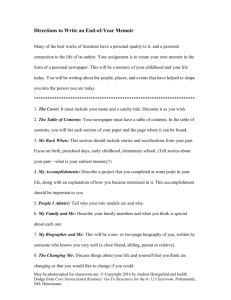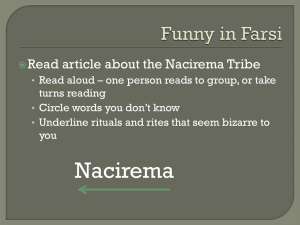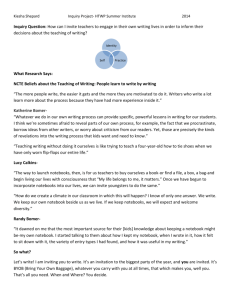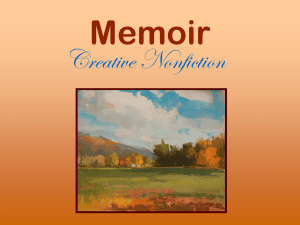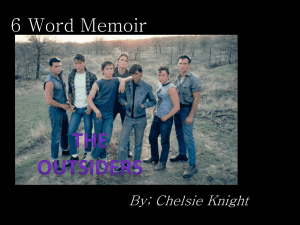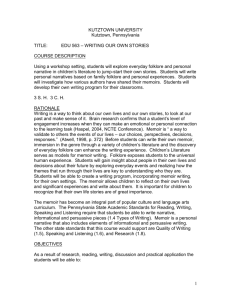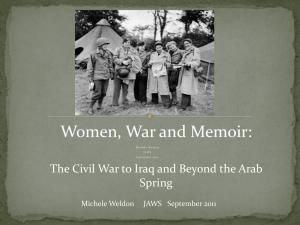LMWP Demo Lesson
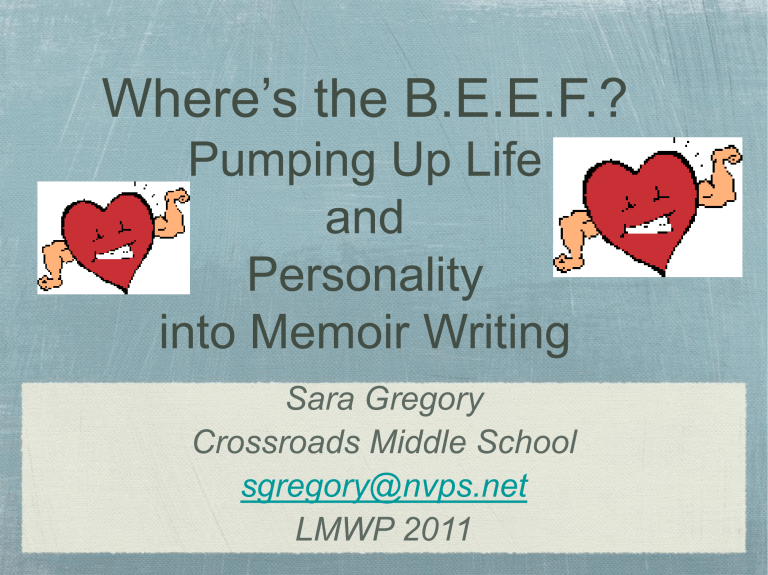
Where’s the B.E.E.F.?
Pumping Up Life and
Personality into Memoir Writing
Sara Gregory
Crossroads Middle School sgregory@nvps.net
LMWP 2011
Problems
Students were creating “bed-to-bed” stories. First this happened, then this, and then it ended. Not focused enough.
They rushed through important events/moments that could be elaborated upon and stretched with more details.
Students resisted revision. Once it’s on paper, it is done.
Writing was lifeless and boring, and as a result, writing scores were low.
Goals
Break the writing into chunks so they could focus on one snapshot at a time.
Provide modeling to guide them through the process.
Make revisions and play with writing before committing ideas into an “official” draft.
Gurus who informed my approach
Gretchen
Bernabei
“When a reader “gets lost” in the writing, it almost feels like they’ve ‘slipped into the skin’ of the writer. This is a goal of good writing, to engage the reader so that they can imagine living the experience they’re reading about.” (Reviving the Essay,
“The lessons in this books are unified in their emphasis on p. 128) process toward product.” (Crunchtime, p. xx)
Big Ideas: students need possibilities, freedom, and feedback
Thomas
Newkirk
“If writing is to be a unique mode of thinking, we should ask how writing can foster and track movement of the mind.”
“As readers, we experience structure as movement through the text; we are propelled from paragraph to paragraph or we come to a standstill, moving on only out of a sense of duty. We can be carried along in an essay that cannot be clearly diagrammed, and we can balk at a structured essay that builds no momentum. Writers create this momentum not by withholding or transforming the mental processes of exploration but by revealing them and allowing the reader to participate in them.”
(Critical Thinking and Writing:
Reclaiming the Essay, p. 14)
Barry Lane
“Writing itself is revision, and if we can teach this concept to children and give them tools to develop it, they will experience the joy of discovery that keeps professional writers at their desks.” (p.5)
“Writers are like photographers with giant zoom lenses, observing life in incredibly fine detail, pulling back to make sweeping generalizations, then zooming in again to make those generalizations come alive with detail...” (p. 32).
“Snapshots” teach writers to write in sharp physical detail.
Penny Kittle
“We don’t learn many things well just by following directions. We have to ride together. The apprenticeship with a master in the field is still the best model for learning.”
“But the instruction has to come during the process of creating the piece, not in polishing the product, or nothing changes.”
(Write Beside Them, p.8)
Defining Memoir
(Bomer, 2005)
Slice of life story make meaning of the past interprets experience statement of who they are and who they are becoming simple stories are made interesting by the author
Process Overview
Memoir Unit: Three Weeks
Examining and Exploring the genre of Memoir
Brainstorming potential memoir topics
Organizing a Memory
Drafting Snapshots
Revising Snapshots with Ba-da-bings
Drafting
Color-coding/Revisions
Editing/Publishing
Brainstorm:
Important Memories
Goal: Generate 5-10 memories
Choose a brainstorm process that suits you. Some possibilities: create a timeline of important events create a web of memories free write about things you remember as they come to you sketch your memories make a list of memories from A-Z answer “Questions for Memoirists”
Kernal Essays
Topic: Lesson Learned:
Where I was and what I was doing:
What happened first?
Next?
What happened last?
Final thoughts?
Text Dude:
Where’s the B.E.E.F?
(Brain, Ears, Eyes, Feet)
Where’s the B.E.E.F.?
Color Coding
RED =talking
YELLOW =thinking
(wondered, thought, emotional reaction, opinion, decision, figured out)
BLUE =seeing/looking
The Mt. Everest of Sand
GREEN =action
“Dang!” exclaimed my friends and I as we looked skyward at the towering mass of sand looming down upon us . Brandon stated, “That’s one big sonofagun hill!”
“I wasn’t fibbing,” our friend Jacob boasted. “Race you!” he yelled back over his shoulder as the swift boy scampered up the base of the mountain. I was making excellent progress, but I hadn’t even covered a quarter of the hill yet.
Now I came to a place where the hill bottlenecked into a steep narrow trail enclosed on each side by vines and long sharp grass that exploded onto a sideways plateau that was two football fields wide with a hundred fifty plus foot drop off on the lower side.
Halfway now and I was panting like a dog. The cool clean breeze coming off Lake Michigan was like a refreshing jump in a pool, but my mouth was a desert sandstorm. The sand pulled at my feet like I was walking through waist deep muck. Being the biggest of the three, I reached the top last and flopped down next to an old burnt black log. “Dude, you have got to see this!” Brandon called down from the highest point to me.
Snapshots
A snapshot is a word picture. Imagine you are reliving each moment that you are writing about.
Keep text dude in mind. Stretch the moment into triple slow motion.
Aim to include at least six sentences for each snapshot.
Snapshot
Sample
Here it comes I thought. This will be the wave I conquer. My stomach stretched along the scratchy surfboard and my arms limply fell over the sides. I slowly began my paddle as the wave moved closer. I craned my neck over my shoulder, checking the wave again, it was creeping up on me. My arms flapped like a bird as I tried to gain momentum. I could hear the swirl of water just behind me now. This is it, I have to catch this wave I said to myself with determination. With as much force as I could muster, I pulled in my hands and gripped the board, propelling myself upward on the board. As quickly as I sprung up, I toppled down. The wave swallowed me and tossed me around like a rock in a tumbler. Ughhh!! Another failed attempt. How long was it going to take me to figure out this surfing bit? I breathed a sigh of frustration as I flopped my body back onto the board and headed back out to the open blue water.
Ba-Da-Bing Sentences
http://www.youtube.com/watch?v=z-jpdWEYuic
Take a moment to look at the student foldable with your partner and locate his/her ba-da-bings. What do you notice?
Ba-da-bing your snapshot
Locate and underline a sentence in each snapshot that is lifeless and could use some revision.
On the flip of the flap, create a new sentence using the Bada-bing approach.
Roses and Thorns
Students were excited about their topics and were motivated to convey the meaning of the memory
Students (particularly struggling students) produced much more detailed writing in the foldable, rough draft, and final draft than previous writing tasks.
I was much more engaged as a reader and they were invested as writers. These were the best memoirs I’ve read in my four years of teaching memoir!
Some kids didn’t “beef up” their snapshots until they drafted.
While some had great ba-dabing sentences, they didn’t transfer into their drafts. (Make no assumptions, model EVERYTHING!!)
I would build in more conferring during the creation of snapshots to ensure students were applying the details and stretching them into triple slow motion.
Reflections
Look through the student foldables at the table and the finished student products on the LMWP blog. What do you notice about their work during the process and the final product? ( I realize they don’t correlate student to student, but what can you infer from stages?)
Were there any new ideas presented that you will take back to your classroom?
How might you adapt the ideas presented to work within the context of your classroom?
What are the benefits and drawbacks to using foldables?
Further questions/comments/suggestions.
Bibliography
Bernabei, Gretchen. Crunchtime.
Portsmouth, NH: Heinemann,
2009.
Bernabei, Gretchen. Reviving The Essay.
Shoreham, VT: Discover
Writing Press, 2005.
Bomer, Katherine. Writing a Life: Teaching Memoir.
Portsmouth, NH:
Heinemann, 2005.
Kittle, Penny. Write Beside Them. Portsmouth, NH: Heinemann,
2008.
Lane, Barry. After the End.
Portsmouth, NH: Heinemann, 1993.
Newkirk, Thomas. Critical Thinking and Writing: Reclaiming the
Essay. ERIC, 1989.
